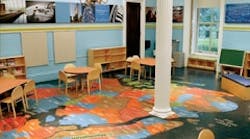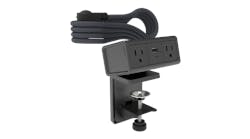In an effort to quantify what constitutes an “environmentally correct” building, the U.S. Green Building Council (USGBC) created the Leadership in Energy and Environmental Design (LEED) rating system. LEED has become the North American standard for what constitutes sustainable design. The LEED guidelines are the best way to differentiate genuinely sustainable projects from environmentally friendly hype.
The flooring that school officials choose for their facilities can earn a project LEED points and enhance the sustainability of a facility.
LEED overview
The LEED rating system has six credit categories:
- Sustainable Sites
- Water Efficiency
- Energy & Atmosphere
- Materials & Resources
- Indoor Environmental Quality
- Innovation & Design
Commercial flooring can contribute points in two of these categories: Materials & Resources, and Indoor Environmental Quality.
It's important to understand that building projects — not the products that are used — are what earn a school facility LEED certification. Projects can earn points by meeting or exceeding each credit category's requirements. There are four possible levels of LEED certification: platinum (the highest certification level), gold, silver and certified.
Rubber choices
One popular type of flooring is rubber flooring. This is especially true in education facilities, where durability is needed. Rubber flooring comes in three basic types: natural, synthetic and recycled. Recycled rubber flooring has the added environmental benefit of using reclaimed content.
These characteristics enable recycled rubber flooring to contribute points toward LEED certification. Following are examples of how recycled rubber flooring can contribute points and potential strategies for using rubber flooring on a project:
EXAMPLE 1
Credit category: Materials & Resources; Credit title: Construction Waste Management; Credit number: MR2.1, MR2.2; Total points flooring can contribute: 2 LEED-NC, 2 LEED-CI, 2 LEED for Schools.
-
Explanation: The goal of this credit is to encourage the diversion of as much waste as possible from landfills. If a flooring manufacturer has a reclamation program, schools can obtain up to two points under this area. For LEED-NC, LEED for Schools and LEED-CI, one point can be attained for recycling or salvaging as least 50 percent of non-hazardous construction and demolition debris (MR2.1). One additional point can be attained for recycling or salvaging an additional 25 percent beyond MR2.1, or 75 percent of non-hazardous construction and demolition debris (MR2.2).
-
Potential strategies for using recycled rubber flooring to attain LEED points:
-
Establish project goals for waste diversion that include reducing disposal in landfills and incinerators.
-
Adopt a construction waste-management plan that includes tracking recycling efforts through the construction process.
-
Return unused, intact recycled rubber flooring products to the manufacturer.
-
Package and ship installation scrap back to the manufacturer or other designated processors for regrinding into other products.
-
Confirm that the manufacturer has a documented reclamation program.
EXAMPLE 2
Credit category: Materials & Resources; Credit title: Recycled Content; Credit number: MR4.1, MR4.2, MRc2; Total points flooring can contribute: 2 LEED-NC, 2 LEED-CI, 2 LEED for Schools, 10 LEED-EB.
-
Explanation: This credit encourages the use of recycled materials. Recycled content is defined by ISO 14021 as “materials that have been recovered or diverted from the solid waste stream either after consumer, commercial or industrial use (post-consumer) or during the manufacturing process (pre-consumer).” Under LEED-NC, LEED for Schools and LEED-CI, one point can be attained if the total sum of recycled content — post-consumer content plus half the value of pre-consumer content — equals at least 10 percent of the total value of materials in the project (MR4.1). An additional point can be attained if it equals 20 percent (MR4.2). The points are attained based on the total value of recycled content of the building, not just one or two products.
-
Potential strategies for using recycled rubber flooring to attain LEED points:
-
Establish project goals for recycled content materials.
-
Identify materials that are truly recycled. Flooring scrap reused in the manufacturing process, although a good environmental practice, does not constitute recycled content.
-
Look for flooring products that contain high levels of post-consumer waste and pre-consumer waste.
EXAMPLE 3
Credit category: Materials & Resources; Credit title: Local/Regional Materials; Credit number: MR5.1, MR5.2, MRc2; Total points flooring can contribute: 2 LEED-NC, 2 LEED-CI, 2 LEED for Schools, 10 LEED-EB.
-
Explanation: Using materials that are extracted and manufactured close to a job site supports the use of local resources and reduces the environmental impacts resulting from transportation. Under LEED-NC and LEED for Schools, one point can be attained if 10 percent of the building materials have been extracted, harvested, recovered or manufactured within 500 miles of the project site (MR5.1). One additional point is attainable if the material value is 20 percent (MR5.2). Similarly, under LEED-CI, one point can be attained if 20 percent of building materials are manufactured within a 500-mile radius (MR5.1); one additional point if 10 percent of the locally manufactured materials are extracted or harvested within 500 miles of the project (MR5.2). Under LEED-EB, points may be attained by purchasing materials that contain at least 50 percent content harvested and processed, or extracted and processed, within 500 miles of the project (MRc2).
-
Potential strategies for using recycled rubber flooring to attain LEED points:
-
Establish project goals, and document the distances where the flooring content is extracted, harvested, recovered or manufactured.
-
Work with locally sourced materials and materials suppliers.
-
Check the sources of derived SBR and EPDM.
EXAMPLE 4
Credit category: Indoor Environmental Quality; Credit title: Low-Emitting Materials; Credit Number: EQ4.1, EQ4.3, MRc3; Total points flooring can contribute: 2 LEED-NC, 2 LEED-CI, 2 LEED for Schools, 2 LEED-EB.
-
Explanation: Indoor Air Quality (IAQ) standards are developed to enhance air quality in buildings, which contributes to the well-being of its occupants. One point can be attained under LEED-NC and LEED for Schools if a floor covering's adhesives and sealants meet the VOC content limits of the South Coast Air Quality Management District (SCAQMD) Rule #1168. (EQ4).
-
Potential strategies for using recycled rubber flooring to attain LEED points:
-
Specify low-VOC materials in construction documents, and ensure that VOC limits are stated clearly in each section where floors, adhesives and sealants are used.
-
Look for adhesives formulated for use with recycled rubber flooring that deliver VOCs lower than the SCAQMD standard. Some adhesives are as much as 50 percent below this standard.
-
Look for flooring with low-VOC emissions. Indicators are third-party certification that the flooring passes strict tests for indoor air quality and low-VOC emissions. The most stringent standards to meet: the State of Washington standard; and the Collaborative for High Performance Schools (CHPS) criteria (Section 01350) for indoor air quality in classrooms as described in the State of California's Department of Health Services Standard Practice.
LEED by example
Architects, designers and facility managers seeking to develop high-performance, sustainable buildings should use LEED as a guide for choosing products for projects and buildings. All LEED projects will require documentation, either in the form of test reports or architectural specifications, to confirm that a manufacturer has the data to back up its claims. If the claim references a specific testing standard or certification, require a letter from the party performing the testing.
LEED certification will involve a rigorous, third-party process that assesses environmental claims and confirms that a building is performing as designed. Trained, certified LEED specialists can assist. The investment of time and resources needed to achieve LEED certification is worth it. LEED-certified buildings not only improve the environment, but also can help qualify institutions for local, state and federal incentives.
Drexler is chief marketing officer for ECORE International, Lancaster, Pa., a manufacturer of environmentally sustainable products including commercial flooring. He can be reached at [email protected] or (717)295-3400, ext. 232.
Flooring impacts
LEED for Schools Credit Areas Impacted by Flooring
MR2.2
MR4.2
MRc2
MR5.2
MRc2
MRc3




